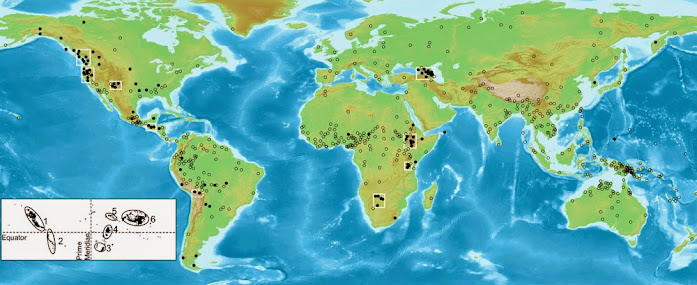Plot of the locations of the languages in the sample. Dark circles represent languages with ejectives, clear circles represent those without ejectives. Clusters of languages with ejectives are highlighted with white rectangles. For illustrative purposes only. Inset: Lat-long plot of polygons exceeding 1500 m in elevation. Adapted from Figure 4 in [8]. The six major inhabitable areas of high elevation are highlighted via ellipses: (1) North American cordillera (2) Andes (3) Southern African plateau (4) East African rift (5) Caucasus and Javakheti plateau (6) Tibetan plateau and adjacent regions. Credit: Caleb Everett, associate professor of anthropology in the College of Arts and Science at the University of Miami

1 posted on
06/15/2013 9:59:32 AM PDT by
SunkenCiv
To: SunkenCiv
7,000 languages I had no idea.
3 posted on
06/15/2013 10:15:55 AM PDT by
chesty_puller
(Viet Nam 1970-71 He who shed blood with me shall forever be my brother. Shak.)
To: SunkenCiv
"ejective consonants are spoken mainly in regions of high elevation" also yodeling
To: SunkenCiv
Well.... that explains Denver.
5 posted on
06/15/2013 10:18:59 AM PDT by
UCANSEE2
(The monsters are due on Maple Street)
To: SunkenCiv
"Since air pressure decreases with altitude and it takes less effort to compress less dense air, I speculate that it's easier to produce these sounds at high altitude." I suspect that the lower the elevation, the easier survival is, therefore lower-elevation cultures don't have to work as hard at staying alive.
At higher elevations there isn't as much food simply growing on trees, so you have to work harder and interact and cooperate with your neighbors in more sophisticated ways, which requires a more sophisticated language.
6 posted on
06/15/2013 10:21:31 AM PDT by
E. Pluribus Unum
(Affirmative action is racial profiling.)
To: SunkenCiv
However, nearly all languages feature edverbs, e.g. want-ed, need-ed, etc...
7 posted on
06/15/2013 10:33:59 AM PDT by
mikrofon
(All in the Past .. tense)
To: SunkenCiv
Interesting:
Caleb Everett, associate professor of anthropology in the College of Arts and Sciences at the University of Miami
I wonder how many millions in grant money he received from “Porkulous#I to enable completion of this study???
(Maybe it was a byproduct of an earlier global warming alert, and smart folks listened to their governments and moved to higher ground!)
10 posted on
06/15/2013 10:39:16 AM PDT by
Noob1999
(Loose Lips, Sink Ships)
To: SunkenCiv
Of course the two most important issues that need to be addressed are: are languages with ejectives threatened by global warming? and do speakers of these languages qualify for affirmative action?
To: SunkenCiv
Yes, this is why Monsieur Pujol, (a.k.a. Monsieur Lepetomane) had his performances in Paris (Altitude 114 feet).
13 posted on
06/15/2013 12:50:31 PM PDT by
caddie
To: SunkenCiv
If his sampling is representative then we should expect over 1000 languages with ejectives, no? It's not clear that his methodology is sound. A sample size from a population limit of 7000 isn't really necessary. Why not just use the entire population, particularly since your focus narrowly concentrates on ejectives?
21 posted on
06/16/2013 4:25:51 AM PDT by
1010RD
(First, Do No Harm)
To: SunkenCiv
Deeeeude. Hey. Whaaaadja say again? Still stoooooooooned off my aaaas from a day a da beach, mannnn.... Souuuuunds totally narly....
26 posted on
06/16/2013 1:31:12 PM PDT by
Yaelle
FreeRepublic.com is powered by software copyright 2000-2008 John Robinson
